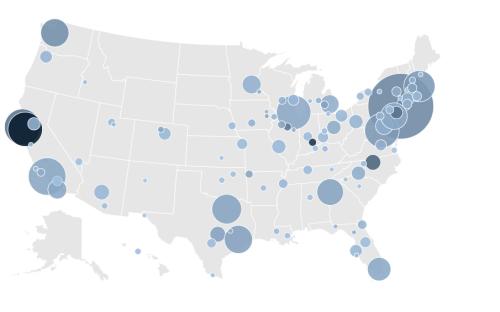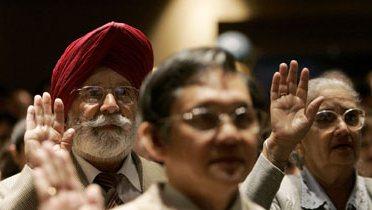

12:30 pm EDT - 1:00 pm EDT
Past Event
12:30 pm - 1:00 pm EDT
Washington, DC
With unemployment still on the forefront of voters’ minds in the upcoming presidential election, and immigration issues also highly politicized, the H-1B visa program for high-skilled workers is hotly debated. Some claim that the visa program hurts American jobs in favor of immigrants, but others argue that the program provides a new, badly-needed source of highly-skilled labor.
Now that Senator Chuck Grassley (R-Iowa) has removed his hold on the “Fairness for High-Skilled Immigrants Act,” will Congress be able enact meaningful reform to the H-1B visa program? How will this program shape the national debate? On July 18, Brookings associate fellow Jill Wilson took your questions and comments in a live web chat moderated by Vivyan Tran of POLITICO.
12:31 Jill Wilson: Welcome everyone, let’s get started.
12:32 Comment From Victor: What are the minimum requirements to obtain this visa?
12:32 Jill Wilson: H-1B workers must possess at least a bachelor’s degree (with the exception of fashion models). About sixty percent have a master’s or PhD.
12:33 Comment From Tim DC: What benefits do companies enjoy from employing H-1B visa workers that make footing the bill for the fee worthwhile?
12:33 Comment From Jennifer: What factors weigh into an employer’s decision to request (and pay for) a visa for an employee rather than hire a U.S. citizen?
12:34 Jill Wilson: These two questions are related. The employers we interviewed as part of the report we released today told us that if they could avoid the cost and hassle of hiring an H-1B worker they would. Employers report difficulty finding qualified workers from their existing local labor markets.
12:35 Comment From Jim: Is there any evidence that the H-1B visa program hurts American workers?
12:35 Comment From Scott B: With the high unemployment and the number of engineers who need jobs, why is the government still issuing H1-B visas? Shouldn’t companies be required to look at the out of work domestic engineers over trying to buy cheaper labor from overseas?
12:36 Jill Wilson: I’ll address these two questions together.
12:36 Jill Wilson: This is a contentious debate. One side says that there is shortage of high-skilled workers in this country and that we need to let in more foreign workers to fill those jobs.
12:37 Jill Wilson: The other side says that, especially during a time of high unemployment, we need to restrict visas in order to give native workers greater opportunity.
12:38 Jill Wilson: The report we released today recommends a standing commission that would be able to look at this issue more closely, using evidence about employment conditions and workforce needs, both at the national level, but especially at the local level since metropolitan economies vary greatly, as does their demand for H-1B workers.
12:38 Comment From Livia: Why haven’t H-1B visa fees been proportionately distributed to metro economies requesting the highest numbers of H-1B workers?
12:38 Comment From Alexandra, MA: What specifically do H-1B visa fees pay for and how are those expenditures determined? Does the federal government play a large role in distributing those funds or is it mostly managed as an interaction between states and metro regions?
12:39 Jill Wilson: One aspect of the H-1B visa program that is not as well known is that the funds paid by employers for these visas are channeled to local areas for workforce training.
12:40 Jill Wilson: This is a competitive grant process, and metropolitan leaders need to, first, know about it in order to be able to apply and, second, have good data at the local level to know what their needs are.
12:40 Jill Wilson: One hope of ours in releasing this report today is that local areas– businesses, workforce development agencies, and educational institutions — can use the data that we have made available on our website to apply for these grants and make the case that they need to boost the skills of their existing workforce.
12:41 Comment From Anonymous User: Can you comment on unemployment rates of STEM workers in various metro regions? Where is unemployment higher or lower and why?
12:42 Jill Wilson: It is true that employment rates vary metro by metro. But overall, those with STEM degrees are less likely to be unemployed than those without STEM degrees. Our Metro Monitor provides unemployment rates for individual metro areas.
12:42 Comment From Jane T: Why did Sen. Grassley have a hold on the legislation, and what made him remove it?
12:45 Jill Wilson: Sen. Grassley placed a hold on the “Fairness for High-Skilled Immigrants Act,” which would lift the country-level limits on green cards, due to his concerns over fraud and displacement of local workers. He is now negotiating with Democrats to bolster safeguards including annual audits of companies using the program.
12:45 Comment From Eduardo, DC: When will Congress address this issue?
12:45 Comment From Salomon Guenun: When will Congress debate the renewal/reform of the current cap on H-1B visas?
12:46 Jill Wilson: Due to the upcoming election and the continued, divided national debate over immigration, we do not expect any movement on this topic during this session.
12:47 Jill Wilson: The area where Congress has been able to come to the most agreement is around high-skilled immigration. There are currently 7 bipartisan bills addressing this issue.
12:48 Comment From h1b victim: My employer hired me on an h1 but neglected to properly file papers with USCIS and lied to me about it. By the time I found out I was already subject to the 10year bar and have no recourse. Why is there no legislation to prevent employers from abusing the system?
12:48 Comment From John: You mentioned in the discussion this morning that there’s a prevailing wage requirement for H-1Bs. But aren’t critics of the program right when they say that the prevailing wage is set too low at the 17th percentile? You can find plenty of examples of this in the LCA data you use. And the GAO found that 54% of the LCA applications were for the lowest wage levels. Would you support a higher prevailing wage floor?
12:49 Jill Wilson: There are a couple protections built into the H-1B program to prevent fraud and abuse. One is the prevailing wage requirement, by which employers must pay H-1B workers a wage that matches what is being paid to other workers doing similar jobs in their area.
12:50 Jill Wilson: The second protection is that USCIS makes unannounced site visits to employers to make sure that the workers they applied for are indeed working there and being paid the prevailing wage.
12:51 Jill Wilson: I am sorry to hear about the situation with your employer. I would suggest hiring a lawyer and/or talking to a congressional representative.
12:51 Comment From Carmen: What is the criteria to qualify as a research institution as it relates to the H-1B visa cap exemption?
12:52 Jill Wilson: To qualify as an uncapped employer in the H-1B visa program, the employer must be an educational institution, non-profit research or government research agency.
12:52 Jill Wilson: The demand from uncapped employers made up about 10% of total demand in 2010-2011.
12:54 Comment From Benjamin: Are American workers simply unable to fill highly-skilled STEM jobs? If so, why?
12:55 Jill Wilson: Some evidence suggests that the pipeline of STEM -trained workers in our country is not keeping up with employer demand. There is also evidence that STEM-trained workers are being diverted to other fields. 64% of the demand for H-1B workers is for STEM fields.
12:55 Comment From Karen: What kinds of reforms are needed for this program?
12:55 Jill Wilson: In addition to a standing commission on labor and immigration, we recommend more strategic use of funds from the visa fees to local workforce training.
12:57 Jill Wilson: The metropolitan areas with the highest demand for H-1B workers are receiving a disproportionately low level of these funds. Our interactive database will allow local areas to analyze the demands of employers in their areas and address the needs for high-demand occupations.
12:57 Comment From Sanjay Bhatt: Is there strong evidence that providing more ETA training grants to educational institutions will turn adult workers into the talent that companies say they can’t find here? Engineering, science and math degrees aren’t exactly popular among college-age students or middle-age workers.
12:58 Jill Wilson: Another funding stream from the H-1B visa program goes toward STEM education at both the college and K-12 levels. These programs aim to inspire students to pursue degrees and occupations in these high-demand fields.
12:59 Jill Wilson: One example of how the ETA funds are meeting the need for high-skilled workers is in Wichita Kansas. Our paper describes the Kansas Engineering Excellence Project which partners with Wichita State University’s engineering department to train workers in the specialized occupations that local employers demand.
1:00 Jill Wilson: Thank you everyone for your great questions. I’m sorry I couldn’t get to all of them.
Read the Metropolitan Policy Program’s new regional analysis of the H-1B visa program »
Related Content

Neil G. Ruiz, Jill H. Wilson, Shyamali Choudhury
July 18, 2012

Neil G. Ruiz
July 16, 2012

Neil G. Ruiz
July 6, 2012

Shyamali Choudhury, Neil G. Ruiz
June 25, 2012

Jill H. Wilson, Neil G. Ruiz
June 13, 2012
12:30 pm - 1:00 pm
Now that Senator Chuck Grassley (R-Iowa) has removed his hold on the “Fairness for High-Skilled Immigrants Act,” will Congress be able enact meaningful reform to the H-1B visa program? How will this program shape the national debate? On July 18, Brookings associate fellow Jill Wilson took your questions and comments in a live web chat moderated by Vivyan Tran of POLITICO.

Aviva Aron-Dine, Wendy Edelberg, Gopi Shah Goda, Ben Harris, Kari Heerman, Nellie Liang, Elena Patel, Sarah Reber, Jessica Riedl
January 13, 2026

Wendy Edelberg, Stan Veuger, Tara Watson
January 13, 2026

December 22, 2025